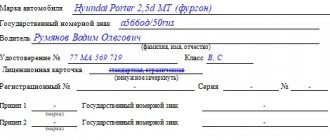Author: Ivan Ivanov
The chart of accounts has elements located directly on the balance sheet and behind it. The second group includes account 002 “Transfer of property for safekeeping.”
It reflects the values that have been deposited in all forms and varieties. Analytical accounting activities on it are carried out by the companies from which these values were received, as well as by the types of property and the places in which it is stored. This norm is prescribed in Resolution of the Ministry of Finance of Russia dated December 20, 2012 No. 77.
How to use
Account 002 is traditionally used to summarize information about the existence and movement of inventory items that are not directly owned by the company. Within the framework of responsible storage, we can talk about the following situations:
- receipt of certain goods and materials from suppliers, payment from them was extended or stopped on legal grounds;
- acquisition of valuables that cannot be spent before payment events within the framework of the current rules and regulations of the contract;
- receipt of goods and materials, for which the agreement specifies a special option for the transfer of ownership rights.
Since the account “works” behind the balance sheet, it reflects items that are not registered. It is active in nature and does not involve double entry rules.
When received, it is entered only as a debit, and when spent, it is entered exclusively as a credit.
What to report: off-balance sheet assets and liabilities
In the activities of an institution, in addition to fixed assets, capital and reserves, property or material rights may arise that are temporarily at the disposal of the organization. Such contingent rights to assets and liabilities cannot be taken on the balance sheet. These transactions should be recorded in off-balance sheet accounts.
The procedure for recording transactions off the balance sheet:
- If an asset is transferred for temporary use under a rental or leasing agreement, then such property is credited to the account. 001. All leased fixed assets are accounted for on an off-balance sheet account for each property separately.
- Material reserves or raw materials accepted for safekeeping. For example, a supplier shipped a low-quality product, for which a decision was made to return the defective product. Until the moment of return shipment, the buyer is obliged to record low-quality goods on the account. 002.
- If a company processes customer-supplied raw materials, then it is necessary to take into account the inventories accepted for processing on the account. 003. It is important to provide additional detail on financially responsible persons, departments or storage locations, types of activities and keep records of customer-supplied raw materials by counterparties.
- If the organization is a commission agent, then material assets accepted for commission should be entered into account 004. Commission inventory items are accepted for accounting at the prices indicated in the transfer acts.
- Record the equipment accepted for installation or installation on accounting account 005. For example, a company entered into an agreement for the installation and commissioning of heating equipment. Heating boilers belong to the customer, therefore, the performing company must accept the boilers as balance until they are installed.
- Strict reporting forms that the organization uses in its activities should be recorded in account 006. Provide details by type of SBS and financially responsible employees.
- Receivables that cannot be collected are written off against the company's losses. But such receivables must still be taken into account for five years in the 007 account for debtors.
- Guarantees for overdue receivables should be credited to the account. 008. For example, the debtor did not repay the receivable on time. The company sent a letter of guarantee for the debt. Issued guarantees are accounted for as debit 009 until the debt is repaid.
- Non-profit organizations and state-owned enterprises record housing assets and some external improvement objects in accounting account 010. An important condition: depreciation is not charged for these objects.
- If a company transfers fixed assets for rent or under a leasing agreement and, according to the terms of the agreement, fixed assets will be accounted for on the balance sheet of the lessee, the transferred property items are accounted for on account 011 for each fixed asset separately.
IMPORTANT!
Balance sheet accounting is subject to control and inventory checks. Carry out an inventory of off-balance sheet accounts according to the general rules from the Order of the Ministry of Finance dated June 13, 1995 No. 49.
Which inventory items are taken into account
As already mentioned, material values that were accepted but cannot be reflected on the balance sheet are subject to accounting in this area:
- damaged goods or items that are defective and do not comply with the set of requirements and characteristics specified in the supply agreement, subject to return measures;
- ownership rights to items that, on the basis of an agreement, are transferred not in the process of direct shipment, but upon payment arrangements;
- Inventory and materials that are subject to accounting on the basis of a pledge transaction agreement;
- commodity items that were paid for, but were not transported from the warehouse in accordance with technical or other details, i.e. are in storage only temporarily;
- products received on the basis of the relevant agreement;
- valuables that arrived at the warehouse by mistake.
Transactions with off-balance sheet accounts
In addition to the main functions of each position, complex operations are also carried out, where several subaccounts are involved in postings at once. For off-balance sheet accounts, accounting activities are carried out in the following areas:
- Reserve fund. For example, cash notes, coins.
- Obligations and guarantees of borrowers.
- Consumables.
- Settlement documentation.
- Accounting for material assets accepted for storage.
- Leased and leased fixed assets.
- Debt write-off.
Three main subgroups
There is no correspondence with the balance, as well as between subaccounts.
Basic postings
The principle of double entry is not necessary here, therefore, in the process of compiling transactions, only the number of the account in question appears. Let's study the main transactions for 002 for debit and credit.
By debit
An approximate list of transactions that are widely used in the process of processing transactions:
- Dt 002 Kt (-). Receipt for safekeeping of valuables that were found to be defective, of poor quality, of the wrong assortment position, or other violations of contractual obligations.
- Dt 002 Kt (-). Product units have arrived at the warehouse, which imply special conditions for the transfer of ownership (not after actual shipment, but during the payment process).
- Dt 002 Kt (-). The items have been paid for, but the buyer has yet to withdraw them, so they are being held in-house.
- Dt 002 Kt (-). The receipt of inventory items occurred on the basis of a storage agreement.
- Dt 002 Kt (-). If the pledgor has not fulfilled the requirements described in the pledge agreement.
By loan
- Dt (-) Kt 002. Goods that were returned to the supplier were written off.
- Dt (-) Kt 002. Write-off for the reason that the valuables became the property of the buyer, who paid for them in good faith and removed them.
- Dt (-) Kt 002. Write-off of funds that were left by the buyer in the warehouse for the purpose of safekeeping.
- Dt (-) Kt 002. Return of commodity items to their legal owner in accordance with the norms of the drawn up storage agreement.
- Dt (-) Kt 002. Sale of positions that were received on the basis of a valid collateral agreement.
Why are off-balance sheet accounts needed?
Off-balance sheet accounts are provided for by the chart of accounts approved by order of the Ministry of Finance of the Russian Federation dated October 31, 2000 No. 94n. There are 11 such accounts in total. They are created to control certain business transactions, assets that are not owned by the organization, as well as contingent rights and obligations. The information on such accounts does not determine the financial position of the company, since it is not data for the balance sheet.
Double entry rules do not apply to such accounts. To reflect the movement on them, a simple entry is made: either by debit for inflows, or by credit for outflows. Let's look at a simple entry using an example.
Example
Kaleidoscope LLC purchased raw materials in the amount of 277,300 rubles. (incl. VAT 18% - RUB 42,300) November 1, 2020. Upon receipt, the warehouse manager discovered that the goods were worth 11,328 rubles. (incl. VAT 18% - 1,728 rubles) came with a defect. According to the contract, the buyer has the right not to accept defective goods, and the supplier is obliged to remove them from the buyer’s warehouse within 3 days. The parties drew up a statement of discrepancies upon acceptance of the goods. The supplier delivered the goods within the stipulated time frame. The following entries were reflected in the accounting of Kaleidoscope LLC.
November 1, 2020:
Dt 10 Kt 60 - 225,400 rubles, high-quality raw materials have been capitalized;
Dt 19 Kt 60 - 40,572 rubles, input VAT is reflected;
Dt 76 subaccount “Calculations for claims” Kt 60 - 11,328 rubles, a claim was submitted to the supplier;
D 002 - 11,328 rubles, defective raw materials remaining in the warehouse of Kaleidoscope LLC are reflected off the balance sheet.
November 4, 2020:
K 002 - 11,328 rubles, defective raw materials were removed by the supplier from the warehouse of Kaleidoscope LLC.
Regulatory regulation
Operations and actions regarding goods that were transferred as inventory for temporary storage are regulated by the norms of current legislation (Orders, Resolutions, acts), as well as accounting documents:
- invoice TORG-12;
- form 1-T;
- uniform M-15;
- an act related to the occurrence of a shortage of goods;
- certificate from the accounting department;
- Bank statement;
- act of acceptance and transfer of inventory items;
- collateral agreement.
This is not the entire list of documents by which activities in this area are regulated, but it is basic.
Results
Off-balance sheet accounting accounts must be used along with “standard” accounts. Failure to use off-balance sheet accounts will lead to the impossibility of generating reliable financial statements and, therefore, is a violation of the law.
Sources
- https://assistentus.ru/buhuchet/zabalansovye-scheta/
- https://nalog-nalog.ru/buhgalterskij_uchet/vedenie_buhgalterskogo_ucheta/uchet_materialnyh_cennostej_na_zabalansovyh_schetah/
- https://buhguru.com/buhgalteria/zabalansovye-scheta.html
- https://www.klerk.ru/buh/articles/461355/
- https://nalog-nalog.ru/buhgalterskij_uchet/vedenie_buhgalterskogo_ucheta/pravila_vedeniya_buhgalterskogo_ucheta_na_zabalansovyh_schetah/
- https://nalog-nalog.ru/buhgalterskij_uchet/vedenie_buhgalterskogo_ucheta/poryadok_primeneniya_zabalansovyh_schetov_buhgalterskogo_ucheta/
- https://www.klerk.ru/buh/articles/472900/
- https://buhguru.com/effektivniy-buhgalter/zabal-uchet-mater-tsennost.html
- https://FB.ru/article/430740/zabalansovyiy-uchet-naznachenie-pravila-vedeniya
[collapse]
Be sure to read! Will the dollar rise in 2020, why is oil getting cheaper, and what does Putin and the coronavirus have to do with it?
Accounting examples
Accounting actions are carried out directly on the account with the supplier and buyer.
Provider
It is carried out only in situations where the right of ownership is transferred to the buyer's side.
Let's look at an example. The organization ODO "Rus" shipped goods worth 50,000 rubles. The buyer side does not accept it due to insufficient quantity. Instead, it only accepts it for safekeeping and sends the corresponding act.
It turns out that the seller places these product items on account 41 in order to reflect the goods transferred for storage. Once returned, they will be entered into warehouse inventory and will remain the property of the seller. In this case, 002 will not be used.
To study the intricacies of using the account in question, it is worth considering another example.
The organization ODO "Rus" sold goods worth 100,000 rubles. On this occasion, a deed of sale was drawn up, payment was made, i.e., ownership was transferred to the buyer, but he did not remove the goods from the warehouse, although he managed to pay for it.
In this case, the seller’s accountant records the goods sold in 002. After the buyers’ purchased goods are removed, a debit will occur from this account.
Buyer
In practice, there are situations in which the buyer is not able to capitalize commodity items within the framework of accounting. For example, when a delay in payment makes itself felt, the delivered goods are of inappropriate quality, defective, or missing in quantity.
So the transaction is “frozen” until funds are deposited as payment. In this situation, as in many others, account 002 comes to the rescue.
A furniture organization sent 10 chairs to a retail facility for a total amount of 5,000 rubles, including VAT of 500 rubles. According to the provisions of the agreement, the store takes ownership of the goods after they have been paid for, and a week later it finally paid for them.
In this case, until the goods were paid for, but were in safekeeping, they were reflected in the debit of account 002. After payment, they were written off.
Thus, account 002 is widely used in modern accounting practice and allows for a large number of transactions.
Accounting for transactions on account 002 using an example
Romashka LLC shipped products worth RUB 59,000 to the buyer. The item had not been paid for on the date of shipment. According to the contract, ownership passes to the buyer upon payment.
In the buyer’s accounting, we will reflect the received goods on off-balance sheet account 002 with the following entries:
| Account Dt | Kt account | Transaction amount, rub. | Wiring Description |
| 002 | — | 50 000 | The goods are accepted for off-balance sheet accounting |
| 19 | 60 | 9 000 | VAT presented by the supplier is reflected |
| On the date of payment: | |||
| 60 | 51 | 59 000 | Payment made to supplier |
| — | 002 | 50 000 | Goods written off balance sheet |
| 41 | 60 | 50 000 | The goods are accepted for balance sheet accounting at the time of transfer of ownership |
| Dt 68/VAT | 19 | 9 000 | Accepted for deduction of VAT presented by the supplier |
- Postings for returning goods to the supplier
- Account 10 Materials in accounting: postings, examples, subaccounts
- The procedure for accounting for inventory items in accounting: postings and documents
- Account 41 in accounting: typical entries, subaccounts and examples
Inventory in safekeeping
For them, the account is used. 002. As a rule, it displays data about cooler bottles. On the day the water arrives, the supplier, along with a standard invoice, submits receipt and expenditure documents (or a combined version of the invoice). The collateral value of the bottles can be taken from these papers or from the contract.
On the account 002 may also include mats provided by the cleaning company. They change periodically according to the acceptance certificate.
From the completeness of the information reflected on the account. 002, the correctness of the property tax calculation will depend. If it is revealed that an enterprise acquired fixed assets and, without any reason, reflected them in off-balance sheet accounting, then it will have to pay a fine, as well as additional tax. In such situations, ownership will be decisive. If the asset was received for rent or free use and capitalized on the account. 01 instead of 001, the consequences will not keep you waiting.









